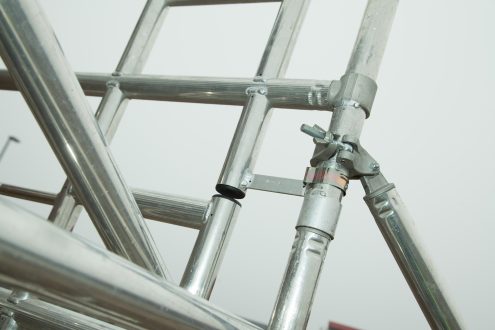What are the different types of Mobile Elevated Working Platforms (MEWPs)
MEWPs, or mobile elevated working platforms, are powered access machines, used in a huge range of construction and warehousing sectors. MEWPs are available in two basic types: boom (cherry pickers) and vertical (scissor lifts).
Boom lifts have two types of operation, static or mobile. These are covered by different training and qualifications.
Vertical lifts can also be static or mobile, and can have a telescopic mast. These are covered by mobile vertical training, or the individual PAV (push around vertical) category.
MEWPs are the safest way for construction staff to work at height, but they’re not without risk. If you want to get a little more clued up on the dangers of work from height, read these articles. And if you want to learn about how to effectively use a full-body harness in a MEWP, this one’s for you.
Push Around Vertical (PAV)
Reach height: 3.60m – 5.10m
IPAF category: PAV
Push around vertical platforms, often called PAVs or personnel lifts, are a small type of mobile vertical lift with scissor operation. PAVs are ideal for indoor low level access making them suitable for smaller warehouses and factories, replacing ladders and steps that are not recommended for safe access.
They are compact and lightweight, which allows them to navigate aisles, doorways and narrow corners, and can be easily moved from location to location, including between floors in multistory buildings.
PAVs meet the requirements of the Work at Height regulations by ensuring the safety of workers on the platform with a low entry point.
Mast Lifts
Reach height: 4.20m – 10.00m
IPAF category: 3a & 3b
Mast lifts are a small type of cherry picker with boom lift operation. They are ideal for low level access in tight spaces and busy environments, such as in retail shops, offices, public buildings and hotels, where traditional cherry pickers or scissor lifts would not be able to access.
They are compact in design so can be used indoors and in restricted spaces without presenting a hazard to other workers, and, because they are small, they can be easily maneuvered into narrow aisles.
Mast lifts meet the requirements of the Work at Height regulations with a caged platform that provides access without the need for ladders/steps.
Scissor Lifts
Reach height: 7.80m – 33.70m
IPAF category: 3a
Scissor lifts are large mobile vertical lifts (sometimes called ‘flying carpets’), similar to PAVs. Ideal for use in a variety applications in both indoor and outdoor spaces, where a straight lift is required for access.
Although narrow width models are available, usually scissor lifts would not be suitable for tighter spaces as they offer a much larger platform area for workers. They are also available as rough terrain versions and with double extending decks.
Scissor lifts meet the requirements of the Work at Height regulations with guard rails around the platform. They provide much safer access to workers required to carry out tasks at height.
Articulating Boom Lift
Reach height: 10.00m – 43.15m
IPAF category: 3b
Articulated boom lifts, most often referred to as a cherry picker, offer an extensive range of movement.
The sideways outreach makes it a practical solution for both indoor and outdoor applications, as the extended reach enables the platform to maneuver around and over obstacles such as buildings and other equipment.
Available in a range of sizes, with additional features including rough terrain option, non-marking tyres and a variety of power options. Articulating boom lifts meet the requirements of the Work at Height regulations.
Stick Boom Lifts
Reach height: 15.45m – 47.70m
IPAF category: 3b
Stick boom lifts, also commonly referred to as telescopic booms, offer an extensive range of movement similar to the articulating boom lift.
The platform can extend sideways, as well as offer great height, so stick booms are ideal for maneuvering around and above obstacles, machinery or buildings. They can be used internally and externally with 4×4 and rough terrain options available.
Stick or telescopic boom lifts meet the requirements of the Work at Height regulations with a caged platform to ensure the safety of workers.
Track Mounts
Reach height: 13.00m – 23.00m
IPAF category: 1b
Track mounted access lifts, sometimes called spider lifts, are the ideal solution for outdoor access requirements when the ground is uneven. They can also be useful on steep inclines, in narrow areas and even on stairs.
They are practical for low-point loading and offer extended height as well as outreach, and the tracked chassis spreads the weight more evenly reducing pressure on the ground, making them perfect for use on soft ground or delicate floors, such as suspended levels.
Track mounts meet the requirements of the Work at Height regulations with a caged platform to ensure the safety of workers.
Truck Mounts
Reach height: 20.00m – 55.00m
IPAF category: 1b
Truck mounted access lifts, also called lorry mounted platforms, are the perfect solution for multi-location projects, as they can travel between sites quickly and be ready to use immediately upon arrival.
They offer exceptional height capabilities, as well as side reach, making the great for outdoor applications and tasks, such as installing signage & telecoms systems, high-level maintenance, pest control and even filming and broadcasting.
Truck mounted access platforms meet the requirements of the Work at Height regulations with a caged platform to ensure the safety of workers.
Health and Safety Training Ltd
If you’re looking to train your staff in the operation of cherry pickers or scissors lifts, simply contact the team at Health and Safety Training Ltd. We provide all the relevant training and certification you require, and can tailor our courses to suit the level of experience of the operatives and your business requirements.
How Safe is Scaffolding? Beware of Falling Materials at Construction Sites






